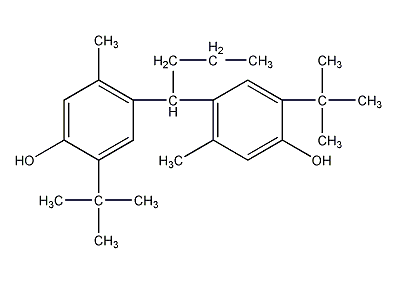
Structural formula
| Business number | 01W2 |
|---|---|
| Molecular formula | C26H38O2 |
| Molecular weight | 382.58 |
| label |
4,4′-Butylenebis(6-tert-butyl-3-methylphenol), 4,4′-Butylenebis(6-tert-butylm-cresol), 4,4′-Butylidenebis(2-(1,1-dimethylethyl)-5-methyl-phenol, Stabilizers and antioxidants |
Numbering system
CAS number:85-60-9
MDL number:MFCD00026289
EINECS number:201-618-5
RTECS number:GO7050000
BRN number:None
PubChem ID:None
Physical property data
1. Physical property data
1. Properties: White crystalline powder.
2. Density (g/mL, 25/4℃): Uncertain
3. Relative vapor density (g/mL, air=1): Uncertain Confirm
4. Melting point (ºC): 212ºC
5. Boiling point (ºC, normal pressure): Uncertain
6. Boiling point (ºC, 5.2kPa ): Uncertain
7. Refractive index: Uncertain
8. Flash point (ºC): Uncertain
9. Specific rotation (º) : Uncertain
10. Autoignition point or ignition temperature (ºC): Uncertain
11. Vapor pressure (kPa, 25ºC): Uncertain
12. Saturated vapor pressure (kPa, 60ºC): Uncertain
13. Heat of combustion (KJ/mol): Uncertain
14. Critical temperature (ºC): Uncertain
15. Critical pressure (KPa): Uncertain
16. Log value of oil-water (octanol/water) partition coefficient: Uncertain
17. Explosion Upper limit (%, V/V): Uncertain
18. Lower explosion limit (%, V/V): Uncertain
19. Solubility: Uncertain
Toxicological data
1. Acute toxicity:
Rat caliber LDL0: 17mg/kg;
2. Other multiple dose toxicity:
Rat caliber TDL0: 1824 mg/kg/1W-C;
Ecological data
None yet
Molecular structure data
5. Molecular property data:
1. Molar refractive index: 119.65
2. Molar volume (cm3/mol): 381.8
3. Isotonic specific volume (90.2K): 937.7
4. Surface tension (dyne/cm): 36.3
5. Polarizability (10-24cm3): 47.43
Compute chemical data
1. Reference value for hydrophobic parameter calculation (XlogP): 8.6
2. Number of hydrogen bond donors: 2
3. Number of hydrogen bond acceptors: 2
4. Number of rotatable chemical bonds: 6
5. Number of tautomers: 45
6. Topological molecular polar surface area 40.5
7. Number of heavy atoms: 28
8. Surface charge: 0
9. Complexity: 444
10. Number of isotope atoms: 0
11. Determine the number of atomic stereocenters: 0
12. Uncertain number of atomic stereocenters: 0
13. Determine the number of chemical bond stereocenters: 0
14. Number of uncertain chemical bond stereocenters: 0
15. Number of covalent bond units: 1
Properties and stability
None yet
Storage method
None yet
Synthesis method
Produced by the condensation of 5-methyl-2-tert-butylphenol and butyraldehyde
Purpose
Used as an anti-aging agent for synthetic rubber and natural rubber, and also used as a copolymer of polyethylene, polypropylene, acrylonitrile, butadiene and styrene, and polyacetal. Heat- and light-resistant stabilizer. It can protect natural rubber and synthetic rubber from thermal oxygen aging, light and ozone aging, so that the color of the rubber will not change under light. For white and colored products, the dosage is 0.56% to 5.0%. It can be mixed with polyamide, dilauryl thiodipropionate, organotin compounds, and phosphites at a dosage of 0.01% to 0.5%.

 微信扫一扫打赏
微信扫一扫打赏

